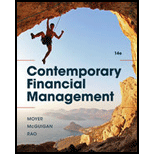
a)
To determine:
a)
Explanation of Solution
Given information:
Cost of debt is 7%,
M is $1,000 and n is 12 (2028-2016)
Calculation of interest:
Hence interest is $87.50
Calculation of value of bond:
Hence, value of bond is $1,139
b)
To determine: Value of bond as on April 15, 2016 with a required rate of return of 9%.
b)
Explanation of Solution
Given information:
Cost of debt is 9%,
M is $1,000 and n is 12 (2028-2016)
Interest is $87.50
Calculation of value of bond:
Hence, value of bond is $983
c)
To determine: Value of bond as on April 15, 2016 with a required rate of return of 9%.
c)
Explanation of Solution
Given information:
Cost of debt is 11%,
M is $1,000 and n is 12 (2028-2016)
Interest is $87.50
Calculation of value of bond:
Hence, value of bond is $854
Calculation of value of Company F bond at 8% interest rate:
Given information:
Cost of debt is 11%,
M is $1,000 and n is 24 (12x2 semi-annually)
Calculation of interest:
Hence, interest is $43.75
Calculation of value of bond:
Hence, value of bond is $1,057
Note: It is assumed that, this answer will require 8% nominal return, but not the effective return and the semi-annual discount rate would be 3.92%.
Want to see more full solutions like this?
Chapter 6 Solutions
Contemporary Financial Management, Loose-leaf Version
- The price-to-earnings (P/E) ratio is used to assess: a) A company’s profitabilityb) A company's debt-to-equity ratioc) The market value relative to earningsd) The liquidity of a stockarrow_forwardWhat does the term "capital structure" refer to? a) The organization of a company’s operationsb) The mixture of debt and equity used to finance a company's assetsc) The relationship between income and expensesd) The structure of a company's management teamarrow_forwardThe Efficient Market Hypothesis (EMH) suggests that: a) All information is publicly available, but not necessarily reflected in stock pricesb) Stocks are always mispriced in the short termc) All public information is fully reflected in stock pricesd) Investors can achieve higher returns through technical analysisarrow_forward
- Don't use ai tool please . What is the primary purpose of diversification in a portfolio? a) To maximize returnsb) To reduce riskc) To increase leveraged) To focus on a single asset classarrow_forwardDon't use chatgpt. A company’s weighted average cost of capital (WACC) is used to: A) Determine the average cost of producing goods B) Evaluate the return on investment projects C) Estimate the company's growth rate D) Measure the level of debt in the companyarrow_forwardWhat is the primary purpose of diversification in a portfolio? a) To maximize returnsb) To reduce riskc) To increase leveraged) To focus on a single asset classarrow_forward
- I need help! A company’s weighted average cost of capital (WACC) is used to: A) Determine the average cost of producing goods B) Evaluate the return on investment projects C) Estimate the company's growth rate D) Measure the level of debt in the companyarrow_forwardNeed help!! What does the term "liquidity" refer to in finance? A) The ability to convert assets into cash quickly without significant loss of value B) The ability to increase company profits C) The level of debt in the company D) The diversity of the investment portfolioarrow_forwardI need answer step by step. A company’s weighted average cost of capital (WACC) is used to: A) Determine the average cost of producing goods B) Evaluate the return on investment projects C) Estimate the company's growth rate D) Measure the level of debt in the companyarrow_forward
- Don't use ai A company’s weighted average cost of capital (WACC) is used to: A) Determine the average cost of producing goods B) Evaluate the return on investment projects C) Estimate the company's growth rate D) Measure the level of debt in the companyarrow_forwardA company’s weighted average cost of capital (WACC) is used to: A) Determine the average cost of producing goods B) Evaluate the return on investment projects C) Estimate the company's growth rate D) Measure the level of debt in the companyarrow_forwardI need help! Which of the following best defines "diversification" in investment? A) Investing in a single type of asset for high returns B) Spreading investments across different assets to reduce risk C) Putting all funds into low-risk bonds D) Focusing on high-risk, high-return investmentsarrow_forward
 EBK CONTEMPORARY FINANCIAL MANAGEMENTFinanceISBN:9781337514835Author:MOYERPublisher:CENGAGE LEARNING - CONSIGNMENTPrinciples of Accounting Volume 1AccountingISBN:9781947172685Author:OpenStaxPublisher:OpenStax College
EBK CONTEMPORARY FINANCIAL MANAGEMENTFinanceISBN:9781337514835Author:MOYERPublisher:CENGAGE LEARNING - CONSIGNMENTPrinciples of Accounting Volume 1AccountingISBN:9781947172685Author:OpenStaxPublisher:OpenStax College Financial Accounting: The Impact on Decision Make...AccountingISBN:9781305654174Author:Gary A. Porter, Curtis L. NortonPublisher:Cengage Learning
Financial Accounting: The Impact on Decision Make...AccountingISBN:9781305654174Author:Gary A. Porter, Curtis L. NortonPublisher:Cengage Learning Cornerstones of Financial AccountingAccountingISBN:9781337690881Author:Jay Rich, Jeff JonesPublisher:Cengage Learning
Cornerstones of Financial AccountingAccountingISBN:9781337690881Author:Jay Rich, Jeff JonesPublisher:Cengage Learning Intermediate Accounting: Reporting And AnalysisAccountingISBN:9781337788281Author:James M. Wahlen, Jefferson P. Jones, Donald PagachPublisher:Cengage Learning
Intermediate Accounting: Reporting And AnalysisAccountingISBN:9781337788281Author:James M. Wahlen, Jefferson P. Jones, Donald PagachPublisher:Cengage Learning College Accounting, Chapters 1-27AccountingISBN:9781337794756Author:HEINTZ, James A.Publisher:Cengage Learning,
College Accounting, Chapters 1-27AccountingISBN:9781337794756Author:HEINTZ, James A.Publisher:Cengage Learning,





